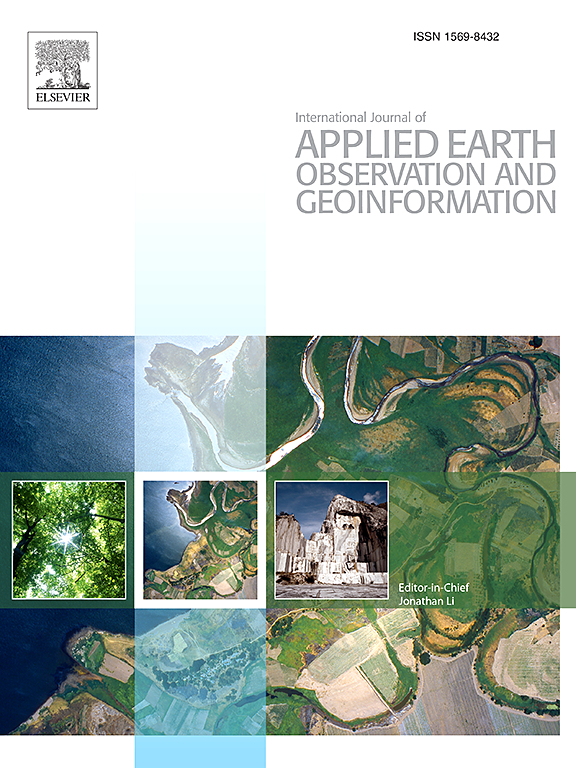Enhancing global aerosol retrieval from satellite data via deep learning with mutual information estimation
IF 7.6
Q1 REMOTE SENSING
International journal of applied earth observation and geoinformation : ITC journal
Pub Date : 2025-04-14
DOI:10.1016/j.jag.2025.104534
引用次数: 0
Abstract
Satellite-based data can provide continuous aerosol observations but suffer from significant uncertainties across various regions. Transfer learning improves model generalization, yet its application in atmospheric research remains limited. Here, we introduce an innovative framework for retrieving global aerosol optical depth (AOD) which named the Aerosol domain-Adaptive Network (AAdaN). The framework utilizes a neural network to estimate mutual information, and aligns spatial covariate shift via a transfer loss term. Then, we assess the retrieval potential in unknown scenarios using independent land cover type, and the proposed model demonstrates satisfactory results. The cross-validation shows strong agreement with in-situ measurements, both in sample-based and site-based evaluations. Specifically, the site-based ten-fold cross-validation of our AOD retrievals indicate that all accuracy metrics are satisfactory, with a Pearson correlation of 0.766 and a Root-Mean-Square Error of 0.118, and that about 76.05 % of the retrievals meet the expected error criteria [±(0.05 + 20 %)]. Additionally, the proposed AAdaN achieves stable, high-accuracy aerosol retrievals across various surface and atmospheric conditions, and can generate spatially continuous AOD distributions. This study significantly improves spatial generalization and offers valuable insights for future model development.
基于互信息估计的深度学习增强全球气溶胶反演卫星数据
基于卫星的数据可以提供连续的气溶胶观测,但在不同地区存在很大的不确定性。迁移学习提高了模型的泛化能力,但在大气研究中的应用仍然有限。本文提出了一种新的气溶胶光学深度(AOD)检索框架,即气溶胶域自适应网络(AAdaN)。该框架利用神经网络来估计互信息,并通过转移损失项对齐空间协变量移位。在此基础上,利用独立的土地覆盖类型对未知情景下的反演潜力进行了评估,结果表明该模型具有较好的反演效果。交叉验证表明,在基于样品和基于现场的评估中,与原位测量结果有很强的一致性。具体来说,我们的AOD检索的基于站点的十倍交叉验证表明,所有准确度指标都令人满意,Pearson相关系数为0.766,均方根误差为0.118,约76.05%的检索满足预期误差标准[±(0.05 + 20%)]。此外,本文提出的AAdaN能够在不同的地表和大气条件下实现稳定、高精度的气溶胶反演,并能够生成空间连续的AOD分布。该研究显著改善了空间概化,为未来模型的发展提供了有价值的见解。
本文章由计算机程序翻译,如有差异,请以英文原文为准。
求助全文
约1分钟内获得全文
求助全文
来源期刊

International journal of applied earth observation and geoinformation : ITC journal
Global and Planetary Change, Management, Monitoring, Policy and Law, Earth-Surface Processes, Computers in Earth Sciences
CiteScore
12.00
自引率
0.00%
发文量
0
审稿时长
77 days
期刊介绍:
The International Journal of Applied Earth Observation and Geoinformation publishes original papers that utilize earth observation data for natural resource and environmental inventory and management. These data primarily originate from remote sensing platforms, including satellites and aircraft, supplemented by surface and subsurface measurements. Addressing natural resources such as forests, agricultural land, soils, and water, as well as environmental concerns like biodiversity, land degradation, and hazards, the journal explores conceptual and data-driven approaches. It covers geoinformation themes like capturing, databasing, visualization, interpretation, data quality, and spatial uncertainty.
 求助内容:
求助内容: 应助结果提醒方式:
应助结果提醒方式:


